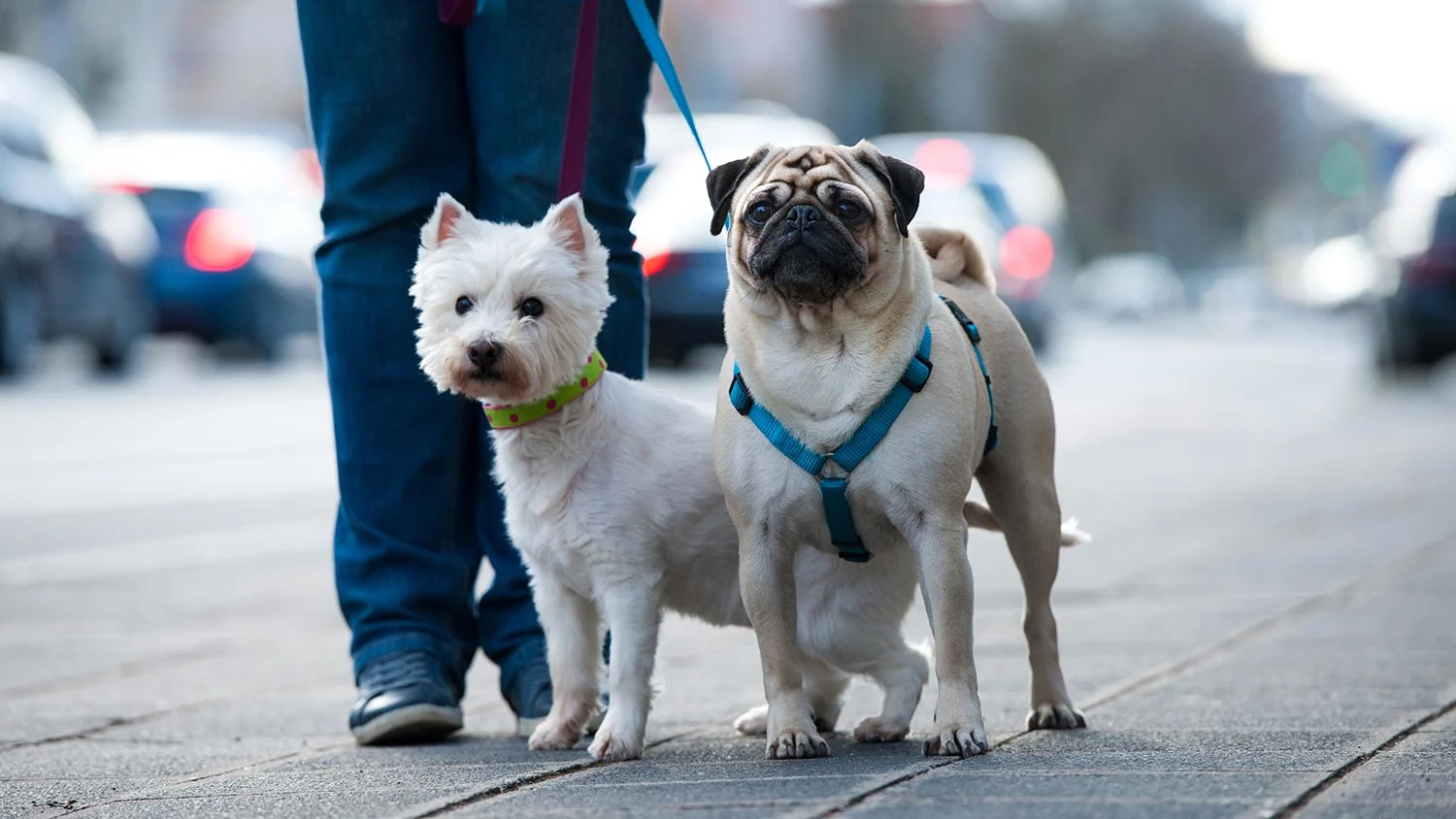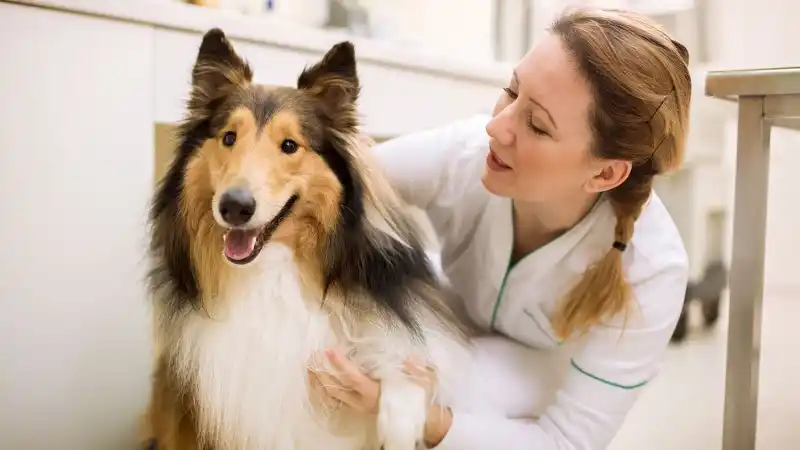City Dog Walking Safety Guide
Taking your dog on errands in the city can be trickier than it seems. Follow these rules for city dog etiquette to keep your urban canine safe and sound.

Living in a busy city with your dog is a great opportunity for adventure! There are cafés to enjoy, endless dog friends around every corner, and plenty of new places to walk and explore. Teaching your dog how to be street smart and high-rise savvy can go a long way in making life in the big city a lot of fun!
A Dog-Friendly City
Being a responsible dog owner doesn’t mean that you have to move to a house with a fenced yard in the suburbs. According to the NYC Department of Health and Mental Hygiene, in February 2017, New York City had 85,085 dogs licensed as residents within the city limits. This was only an estimated 20% of the actual dog population! Many cities are focusing on becoming dog-friendly as the number of dog owners in the United States rises. Increasingly, cafes and restaurants offer patio seating, so your dog can dine with you. Dog parks are popping up all over cities to give pups a place to run and burn off energy, and many transportation services including taxis and subways will allow dogs along for the ride if they are confined in a carrier.
Practicing Proper Obedience
From the first day you bring your puppy home, you should start teaching him how to be an upstanding citizen. Puppies under twelve weeks old can learn how to wear a collar, how to accept praise, and basic housetraining. After twelve weeks, you can begin to teach key commands such as come, sit, stay, heel, and lay down. As your dog gets older, you can introduce more difficult commands such as leave it and wait, which will help to keep your dog safe while living in the city. The American Kennel Club offers an Urban Canine Good Citizen Certification to test your dog’s ability to obey commands that allow for him to live safely in a city environment.
Navigating the Streets
Your dog should remain on a leash when outside of your home, especially in a busy city where he could run off and get lost or hit by a vehicle. Teach your dog street safety and insist that he always stop at the edge of curbs and wait for your cue before crossing. Learning to wait at curbs will keep your dog from attempting to cross the road before you’re ready and ending up in the path of an unsuspecting vehicle.

Every Dog and Cat Deserves the Pet Insurance of Champions
Get prize-winning care for your pets.
Running Errands with Fido
Living in a city, chances are you walk or bike to your errands and often take your dog with you. Some dog owners will tie their dogs outside of a store as they run in for a few items, leaving the dogs alone in the elements. Even if you’re only planning on going in “for a few minutes,” your dog is now alone and at risk. He could be startled by a loud sound, escape his collar, and run off. Or he could be stolen by someone passing by in the crowd. If you’re going to take your dog with you when you need to pop into a store that isn’t dog-friendly, bring a friend who can hold your dog. The DogSpot sidewalk houses are another great option as they provide a secure, temperature-controlled location to leave your dog outside of a store for a short duration of time.
Trash Troubles
It’s well known that city streets aren’t the cleanest, and unfortunately your dog’s face is right at trash level! Keep your dog from getting into trash and recycling bins and keep an eye out for any loose trash lying on the street. Some dogs like to graze as they walk, and this could lead to them eating something toxic. Teaching your dog the “leave it” command at an early age will keep him out of trouble on the street.
Pedestrian Traffic
Walking your dog on a busy sidewalk can be dangerous for small dogs. If you think the sidewalk may be too heavily trafficked, consider picking up your dog until you reach a location with more space. While large dogs are easily seen and avoided by pedestrians, a small dog can get lost under all those feet and may get stepped on. Regardless of size, some dogs may be anxious of large crowds of people. If your dog seems nervous when walking on a busy street, try to take your walks in less populated areas or find a nearby park where there is more room for your dog to have his personal space.
Weather Woes
During the summer months, the temperature of a cement sidewalk in direct sunlight will generally become ten or more degrees hotter than the air temperature. When air temperatures reach 95 degrees, a sidewalk in direct sunlight can feel like 125 degrees! Walking your dog on this hot sidewalk can cause his pads to crack and burn, so refrain from walking during the hottest part of the day and stick to sidewalks that are shaded. If you have to walk during the hotter parts of the day, put protective boots on your dog or carry him to shaded areas of sidewalk.
In the winter, be careful of ice that may create a falling hazard. Teach your dog not to pull when walking on the leash to reduce the chance that you’ll become unbalanced and slip. Many cities treat their roads and sidewalks with chemicals to help snow melt faster, so try to keep dogs off treated sidewalks. If this isn’t possible, protective winter boots can help! After each walk, clean and dry your dog’s feet to ensure snow or chemical residue isn’t trapped in his fur or between his toes.

Every Dog and Cat Deserves the Pet Insurance of Champions
Get prize-winning care for your pets.
Happy in a High-Rise
In most cities, the cheapest option is living in an apartment building. Finding a dog-friendly building can be a challenge, so being a hospitable neighbor and keeping your dog under control is important. Don’t let your dog run loose through the hallways even if he knows which door leads to home.
Your dog may need to learn to navigate the elevator if you live on a higher floor. After the first few rides, most dogs become comfortable with the movement of an elevator. Despite this, you should always keep your dog close to you and never drop his leash to let him enter or exit on his own. Loose leashes can become caught in an elevator door and will quickly become a neck injury hazard as the elevator begins to move. Your dog may also make a last-minute decision to leap off the elevator as the doors are closing, leaving you unable to catch him as he takes off into the city.
Living on a higher floor can mean great views of the city, but it also means your pet is at risk of falling from a height. Keep windows and balcony doors closed unless you are in the room to supervise your dog. Ensure that windows have secured screens and that your balcony railing has posts close enough together that your dog can’t slip through.
If You Work Like a Dog…
Odds are good that you’ll have to hire a dog walker to come in and give your dog a bathroom break and a chance to stretch his legs during the day. Finding a reputable dog walker that you trust can be difficult. Talk to other dog owners at work or in your building; some walkers will give discounts to buildings that have a certain number of dogs that use their services. Be sure that the dog walker you choose is trustworthy as they will have access to your home and be responsible for the well-being of your dog during the day.
City Living
No matter the square footage of your apartment or home in the city, giving plenty of walks, establishing proper obedience, and providing love are all it takes to raise a well-adjusted city dog. Keeping safety in mind throughout the day and preparing your dog for everything he’ll encounter outside of your home will give you both the opportunity to enjoy the benefits of living in the big city!

Every Dog and Cat Deserves the Pet Insurance of Champions
Get prize-winning care for your pets.

Mary comes to AKC Pet Insurance with an extensive background in animal care. As a lifelong animal lover, she has a passion for promoting pet health and wellness. Mary lives in Kentucky with her orange kitty, "Cat" and her dog, " Wubbi".
READ MORE ARTICLES

